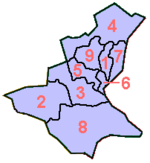
Stari Grad, Sarajevo
Encyclopedia

Sarajevo
Sarajevo |Bosnia]], surrounded by the Dinaric Alps and situated along the Miljacka River in the heart of Southeastern Europe and the Balkans....
, Bosnia and Herzegovina
Bosnia and Herzegovina
Bosnia and Herzegovina , sometimes called Bosnia-Herzegovina or simply Bosnia, is a country in Southern Europe, on the Balkan Peninsula. Bordered by Croatia to the north, west and south, Serbia to the east, and Montenegro to the southeast, Bosnia and Herzegovina is almost landlocked, except for the...
. It is the oldest and most historically
History
History is the discovery, collection, organization, and presentation of information about past events. History can also mean the period of time after writing was invented. Scholars who write about history are called historians...
significant part of Sarajevo
Sarajevo
Sarajevo |Bosnia]], surrounded by the Dinaric Alps and situated along the Miljacka River in the heart of Southeastern Europe and the Balkans....
. At its heart is the Baščaršija
Bašcaršija
Baščaršija is Sarajevo's old bazaar and the historical and cultural center of the city. Baščaršija was built in the 15th century when Isa-Beg Isaković founded the town. The word Baščaršija derives from the Turkish language...
, the old town market sector where the city was founded by the Ottomans in the 15th century.
Features
The municipalityMunicipality
A municipality is essentially an urban administrative division having corporate status and usually powers of self-government. It can also be used to mean the governing body of a municipality. A municipality is a general-purpose administrative subdivision, as opposed to a special-purpose district...
of Stari Grad is characterized by its many religious
Religion
Religion is a collection of cultural systems, belief systems, and worldviews that establishes symbols that relate humanity to spirituality and, sometimes, to moral values. Many religions have narratives, symbols, traditions and sacred histories that are intended to give meaning to life or to...
structures, and examples of unique Bosnian architecture. The eastern half of Stari Grad consists of the Ottoman influenced sectors of the city, while the western half showcases an architecture and culture
Culture
Culture is a term that has many different inter-related meanings. For example, in 1952, Alfred Kroeber and Clyde Kluckhohn compiled a list of 164 definitions of "culture" in Culture: A Critical Review of Concepts and Definitions...
that arrived with Austria-Hungary
Austria-Hungary
Austria-Hungary , more formally known as the Kingdoms and Lands Represented in the Imperial Council and the Lands of the Holy Hungarian Crown of Saint Stephen, was a constitutional monarchic union between the crowns of the Austrian Empire and the Kingdom of Hungary in...
, symbolically representing the city as a meeting place between East and West.
The population of Stari Grad is slightly above 50,000, making it the least populous of Sarajevo's four municipalities. Its population density of 742.5 inhabitants per km² also ranks it last among four. Stari Grad contains numerous hotel
Hotel
A hotel is an establishment that provides paid lodging on a short-term basis. The provision of basic accommodation, in times past, consisting only of a room with a bed, a cupboard, a small table and a washstand has largely been replaced by rooms with modern facilities, including en-suite bathrooms...
s and tourist attractions including the Gazi Husrev-beg's Mosque
Gazi Husrev-beg's Mosque
The Gazi Husrev-beg Mosque , is a mosque in the city of Sarajevo, Bosnia and Herzegovina. It is considered the most important Islamic structure in the country and one of the world's finest examples of Ottoman architecture...
, Careva Džamija, and the Sarajevo Cathedral.
1971
126.598 total- Muslims - 74.354 (58,73%)
- Serbs - 27.658 (21,84%)
- Croats - 12.903 (10,19%)
- Yugoslavs - 5.944 (4,69%)
- Others - 5.739 (4,55%)
1991
50.744 total- Muslims - 39.410 (77,66%)
- Serbs - 5.150 (10,14%)
- Croats - 1.126 (2,21%)
- Yugoslavs - 3.374 (6,64%)
- Others - 1.684 (3,35%)
Sites
Prior to 1914, the Austro-HungariansAustria-Hungary
Austria-Hungary , more formally known as the Kingdoms and Lands Represented in the Imperial Council and the Lands of the Holy Hungarian Crown of Saint Stephen, was a constitutional monarchic union between the crowns of the Austrian Empire and the Kingdom of Hungary in...
who ruled Sarajevo
Sarajevo
Sarajevo |Bosnia]], surrounded by the Dinaric Alps and situated along the Miljacka River in the heart of Southeastern Europe and the Balkans....
wanted land in the Sarajevo Old Town district to build a city hall and library. The land had a home on it and, despite offering the owner money, he refused and continued to refuse even when told that he had to move. When the officials threatened him, he moved the house and rebuilt it, piece by piece, on the other side of the Miljacka
Miljacka
The Miljacka is a river in Bosnia and Herzegovina that passes through Sarajevo and East Sarajevo. It is famous for being "Sarajevo's River", and it has come to be identified immediately with the city itself....
river, as a way of spiting the officials. The Sarajevo Spite House
Spite house
A spite house is a building constructed or modified to irritate neighbors or other parties with land stakes. Spite houses often serve as obstructions, blocking out light or access to neighboring buildings, or as flamboyant symbols of defiance...
operates today as a restaurant is called "Inat Kuca" which means "Spite House."
External links
- http://www.starigrad.ba/

